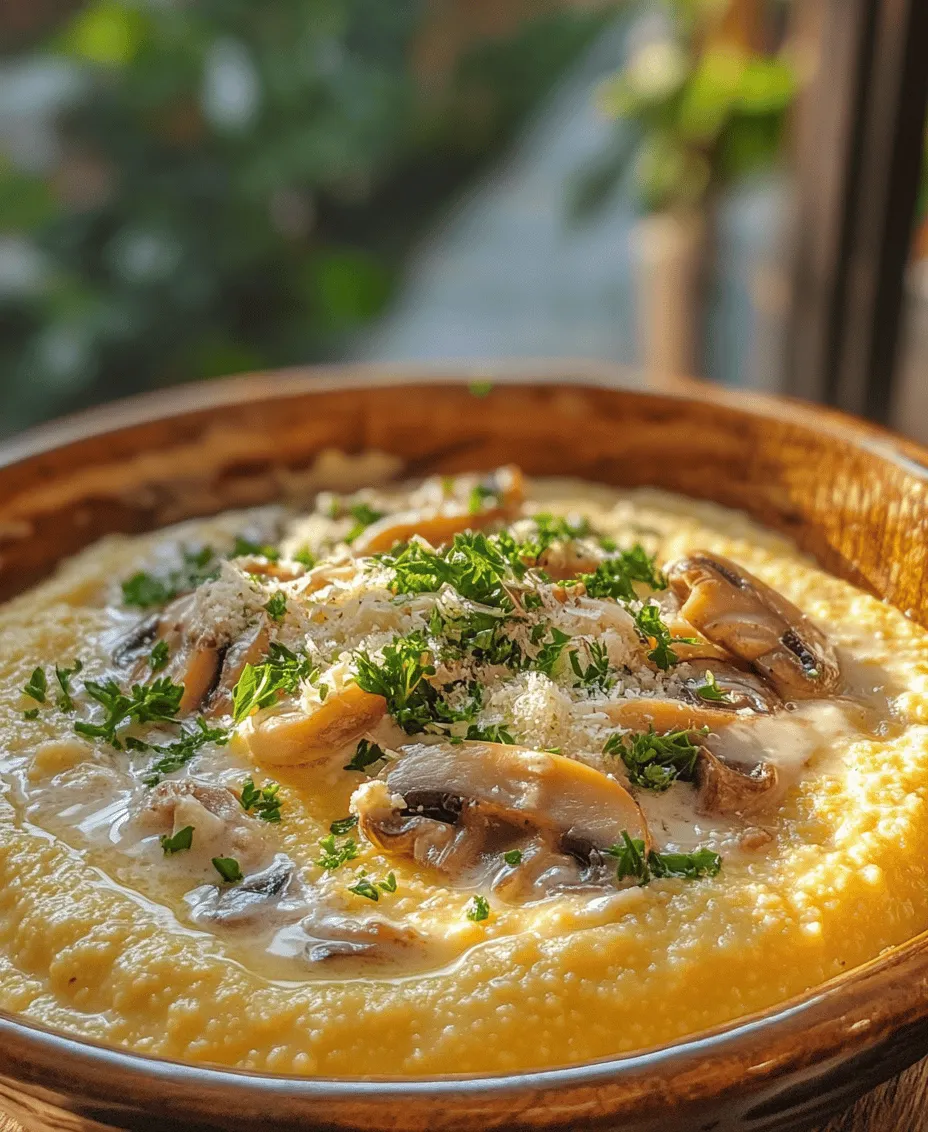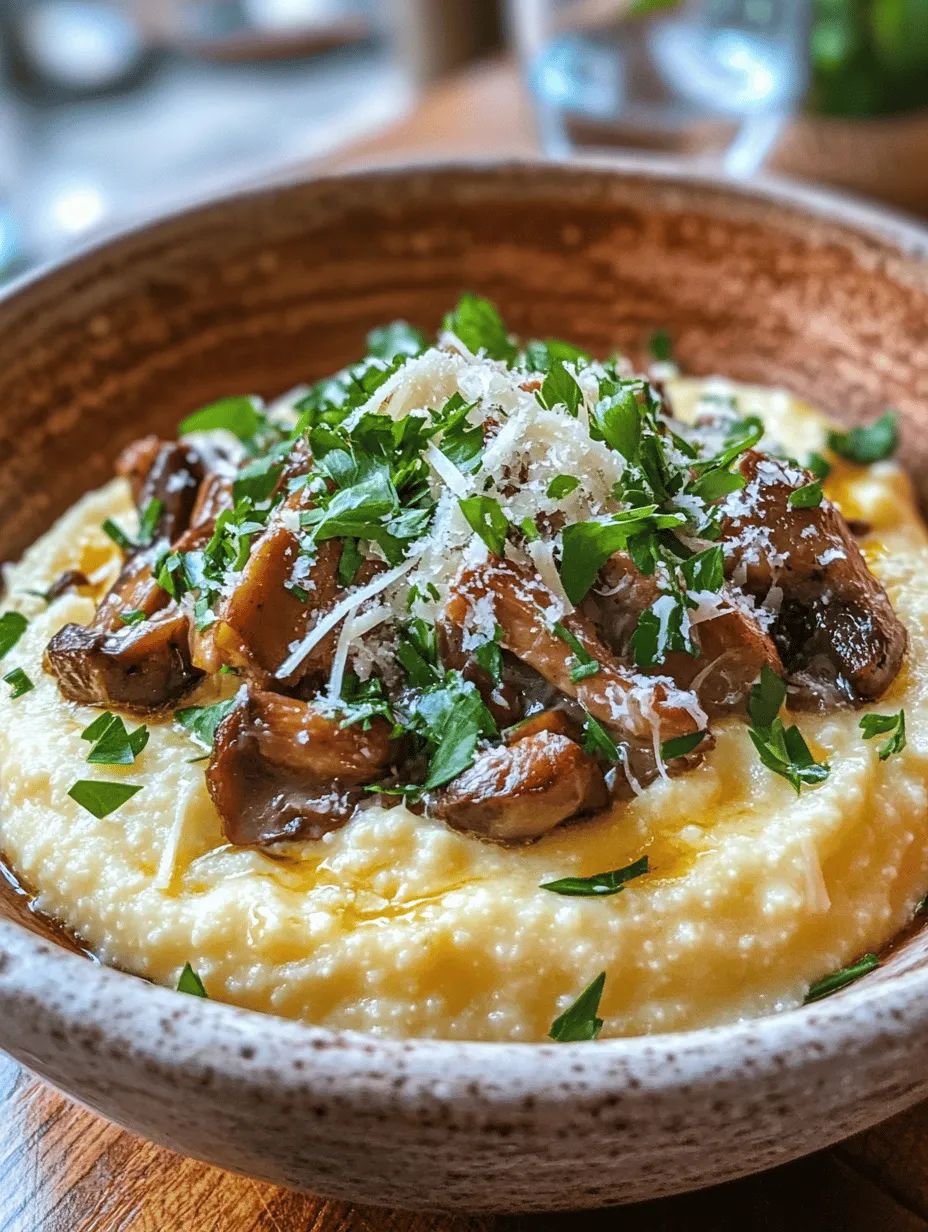Introduction to Creamy Dreamy Polenta
Polenta, a dish often associated with comfort, brings warmth and satisfaction to the dinner table. This Italian staple has found its way into various cuisines worldwide, celebrated for its versatility and ease of preparation. The creamy texture of polenta can transform a simple meal into something truly special, making it a perfect choice for both casual family dinners and more formal gatherings. Whether served as a side dish or the main attraction, creamy polenta offers a delightful base for a myriad of toppings, allowing for endless culinary creativity.
The beauty of polenta lies not only in its comforting flavor but also in its adaptability. It can be served soft and creamy, reminiscent of a luxurious risotto, or allowed to cool and set, then sliced and grilled or fried for a crispy exterior. This adaptability makes polenta suitable for any occasion—whether you’re hosting a cozy family night or an elegant dinner party.
In this article, we will delve into the world of creamy dreamy polenta, exploring its history, essential ingredients, and step-by-step instructions to achieve the perfect dish.
Understanding Polenta: A Culinary Staple
Historically, polenta has roots that trace back to ancient times, originally made from various grains before cornmeal became the predominant ingredient in this beloved dish. The introduction of corn to Europe in the 16th century marked a significant evolution in polenta’s preparation, particularly in Italy where it became a staple food for the peasantry. As a hearty dish, polenta provided sustenance and comfort, often served alongside vegetables, meats, or sauces.
Over the years, polenta has transcended its humble beginnings, evolving into an emblem of Italian cuisine that has captivated food enthusiasts around the globe. Today, it is appreciated not just for its flavor but also for its health benefits. Cornmeal is naturally gluten-free, making polenta an excellent option for those with gluten sensitivities or celiac disease. Additionally, cornmeal is rich in fiber, vitamins, and minerals, promoting digestive health and offering a wholesome alternative to traditional grain-based dishes.
As polenta continues to gain popularity, chefs and home cooks alike have embraced its potential, experimenting with various flavors and textures. From creamy polenta topped with rich sauces to grilled polenta cakes adorned with fresh vegetables, this dish has become a canvas for culinary expression.
Essential Ingredients for Creamy Dreamy Polenta
To create the perfect creamy dreamy polenta, selecting high-quality ingredients is crucial. Each component plays a significant role in achieving the desired flavor and texture. Here’s a breakdown of the essential ingredients you’ll need for this delightful dish:
Coarsely Ground Cornmeal (Polenta)
The foundation of any polenta dish is the cornmeal itself. For creamy polenta, coarsely ground cornmeal is preferred, as it provides a delightful texture and creaminess when cooked properly. The grind of the cornmeal affects the cooking time and final consistency—coarse cornmeal will yield a heartier, more textured polenta, while finer grinds can create a smoother result. Look for high-quality, organic cornmeal for the best flavor and texture.
Vegetable or Chicken Broth
Incorporating broth instead of water is essential for enhancing the flavor of your polenta. Whether you choose vegetable or chicken broth, the rich, savory liquid infuses the cornmeal with depth, making it far more flavorful. Homemade broth is a fantastic option, but store-bought varieties can work just as well—just be mindful of the sodium content. If you’re cooking for a crowd with varying dietary preferences, vegetable broth ensures everyone can enjoy this dish without concern.
Unsalted Butter
Butter adds a layer of richness and creaminess to the polenta. The unsalted variety allows you to control the seasoning, ensuring your dish does not become overly salty. As the butter melts into the polenta, it contributes to a luxurious mouthfeel, making each bite indulgent. For those looking for a dairy-free alternative, consider substituting with olive oil or a dairy-free margarine.
Parmesan Cheese
While optional, Parmesan cheese elevates the flavor profile of your polenta significantly. The nutty, salty notes of freshly grated Parmesan provide a delightful contrast to the sweetness of the cornmeal. If you’re following a dairy-free diet, nutritional yeast can be a fantastic substitute, offering a cheesy flavor without any dairy.
Heavy Cream or Milk
To achieve that signature creamy texture, heavy cream or milk is often added to the polenta. These ingredients enrich the dish and create a velvety consistency that is hard to resist. If you prefer a lighter option, whole milk can be substituted for heavy cream. For vegan versions, consider using unsweetened almond milk or oat milk to maintain the dish’s creaminess without dairy.
Seasoning
Salt and pepper are fundamental in bringing out the flavors of the polenta. Seasoning should be adjusted to taste, but it is essential to add salt to the boiling broth before incorporating the cornmeal. This ensures the polenta is well-seasoned throughout the cooking process.
Garnishes and Toppings
One of the most exciting aspects of polenta is its versatility when it comes to toppings. Sautéed mushrooms, roasted vegetables, or a fresh herb garnish can transform your polenta into a stunning centerpiece. Consider drizzling with a balsamic reduction or serving alongside a rich ragu for a heartier meal. The visual appeal of vibrant toppings not only enhances the dish’s presentation but also adds layers of flavor that complement the creamy polenta beautifully.
Step-by-Step Instructions for Perfect Polenta
Creating creamy dreamy polenta is a straightforward process that requires just a few key steps. Here’s a comprehensive guide on how to prepare this delightful dish, starting with the crucial step of preparing the broth.
Preparing the Broth
1. Choose Your Broth: Start by selecting your preferred broth—vegetable or chicken. If you have homemade broth on hand, that’s even better! Using high-quality broth enhances the overall flavor of your polenta.
2. Boil the Broth: In a medium-sized saucepan, bring your broth to a rolling boil over medium-high heat. This step is essential, as adding the cornmeal to boiling liquid helps to prevent clumping and ensures an even cooking process.
3. Season the Broth: Once the broth reaches a boil, add salt to taste. This is the moment where you can infuse the broth with flavor, so don’t be shy! Stir well to dissolve the salt completely.
4. Prepare for the Cornmeal: As the broth continues to boil, prepare yourself to add the cornmeal. It’s best to have your cornmeal measured out and ready for quick incorporation.
Following these initial steps with precision will set the stage for a perfectly creamy polenta, ready to absorb flavors and transform into a delightful dish for any occasion. Next, we will continue with the detailed preparation process, guiding you through each step of making creamy dreamy polenta that will impress your family and guests alike. Stay tuned for the continuation of this culinary adventure!

Whisking in the Polenta
To achieve a perfectly creamy polenta, the whisking process is crucial. Start by gradually adding the polenta to the boiling liquid while continuously whisking. This technique helps to prevent lumps, ensuring a smooth consistency. It’s essential to use a whisk rather than a spoon, as the whisk’s shape allows for more even mixing and aeration of the polenta. If you find yourself with a few stubborn lumps, don’t panic; they can usually be smoothed out with a bit more vigorous whisking. If necessary, you can also use an immersion blender to blend the polenta after cooking it for a few minutes. The goal is to create a silky, lump-free mixture that will serve as the base for your delicious creamy polenta.
Cooking the Polenta
Cooking polenta is a straightforward process, but it does require attention to detail. After whisking in the polenta, reduce the heat to low to maintain a gentle simmer. Stir frequently with a wooden spoon or a ladle to prevent sticking and ensure that it cooks evenly. The cooking time will vary depending on the type of polenta you’re using—instant polenta will cook in about 5 minutes, while traditional stone-ground polenta may take 30-45 minutes. Polenta is done when it pulls away from the sides of the pot and has thickened to your desired consistency. Keep in mind that it will continue to thicken as it cools, so aim for a slightly softer texture while cooking.
Incorporating Cream and Cheese
Once your polenta is cooked to perfection, it’s time to elevate it by incorporating cream and cheese. The addition of heavy cream will give the polenta its signature creamy texture, while cheese adds depth and flavor. Stir in the cream and allow it to warm through before adding your choice of cheese—Parmesan, cheddar, or even a tangy goat cheese work beautifully. It’s crucial to mix thoroughly until the cheese is melted and evenly distributed throughout the polenta. This step is what transforms it from a basic side dish into a luxurious, comforting experience. For an extra touch of richness, consider adding a dollop of butter at the end.
Seasoning to Perfection
Seasoning is where you can let your creativity shine. Start with a generous pinch of salt, which is essential for enhancing the flavors of the polenta. Taste as you go along, adjusting the seasoning to suit your preference. You can also explore a variety of spices and herbs to elevate the dish further. For a bit of heat, consider adding a pinch of red pepper flakes or a dash of hot sauce. Fresh herbs like thyme, rosemary, or chives can add a refreshing note. Garlic powder or roasted garlic can contribute a rich, savory flavor. Don’t hesitate to experiment with different flavor profiles until you find the perfect balance that pleases your palate.
Serving Suggestions
When it comes to serving creamy polenta, presentation can be just as important as taste. Spoon the polenta into bowls or onto plates, creating a small well in the center for toppings. Some delicious options include sautéed mushrooms, roasted vegetables, or a rich tomato sauce. For a protein-packed meal, try topping it with grilled chicken, shrimp, or a hearty stew. A sprinkle of fresh herbs or a drizzle of high-quality olive oil can enhance the visual appeal and flavor profile. The creamy polenta serves as a perfect canvas for various toppings, making it versatile enough to suit any occasion.
Variations of Creamy Polenta
Vegan Options
For those following a plant-based diet, creamy polenta can easily be adapted. Substitute the heavy cream with a plant-based alternative like coconut milk or almond milk to retain that creamy texture. For the cheese, nutritional yeast can provide a cheesy flavor without the dairy, or you can use a vegan cheese brand that melts well. This way, you can still enjoy the comforting essence of creamy polenta while adhering to a vegan lifestyle.
Flavor Enhancements
To take your polenta to the next level, consider adding flavor enhancements. Fresh or dried herbs can infuse the dish with aromatic notes; basil and oregano work particularly well. If you’re a garlic lover, incorporating minced garlic during the cooking process will impart a savory depth. You might also try adding a splash of white wine or balsamic vinegar for a hint of acidity, which can beautifully contrast the creamy texture of the polenta.
Regional Twists
Polenta is a staple in various cultures, and each region has its unique approach. For instance, in Northern Italy, polenta is often served with a rich meat ragu or alongside grilled sausages. In Brazil, polenta (polenta frita) is sometimes made into fritters, offering a delightful crispy texture. Explore regional twists by incorporating local ingredients—like smoked paprika for a Southern flair or fresh corn kernels for a seasonal touch.
Nutritional Benefits of Polenta
Polenta is not just delicious; it also boasts a range of nutritional benefits. Made primarily from cornmeal, polenta is high in carbohydrates, making it an excellent energy source. It is gluten-free, making it a perfect option for those with gluten sensitivities or celiac disease. Additionally, polenta is a good source of dietary fiber, which aids in digestion and can help you feel full for longer periods. It provides essential vitamins and minerals, including B vitamins, magnesium, and iron, contributing to overall health. Incorporating polenta into your meals can be a tasty way to enjoy a gluten-free option while reaping its nutritional rewards.
Serving Ideas and Pairings
Creamy polenta is incredibly versatile and pairs well with a variety of dishes. For a comforting meal, serve it alongside grilled meats, such as steak or chicken, allowing the juices to soak into the polenta. Hearty stews, like beef bourguignon or mushroom ragout, are excellent companions, providing a rich contrast to the creamy base. In summer, fresh salads with seasonal vegetables can lighten the dish, providing a refreshing balance. Consider topping your polenta with grilled vegetables, fresh herbs, or even a light drizzle of pesto for a seasonal twist that enhances both flavor and presentation.
Conclusion: Embracing the Comfort of Creamy Dreamy Polenta
In summary, creamy dreamy polenta is a delightful dish that offers comfort, versatility, and an array of culinary possibilities. Whether you enjoy it as a base for proteins, topped with vegetables, or as a stand-alone comfort food, this dish is sure to please. The ease of preparation allows for experimentation with flavors and textures, making it an ideal addition to your culinary repertoire. With its nutritional benefits and adaptability to various dietary preferences, creamy polenta can be a staple in your kitchen for years to come. Encourage yourself to explore the different variations and toppings, discovering the unique ways to make this dish your own. Embrace the warmth and satisfaction that comes with creamy dreamy polenta, and let it become a cherished favorite in your home.



